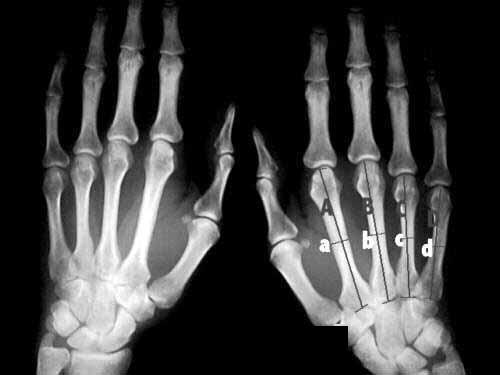Definition
arachnodactyly, dolichostenomelia; spider finger; a condition in which the hands and fingers, and often the feet and toes, are abnormally long and slender; a characteristic of Marfan's syndrome and Achard syndrome.
|
Radiographic Appearance
Radiologicaly the hands are imaged and measurements taken.
When arachnodactyly is subtle, the metacarpal index can be determined by dividing the length of each of the last four metacarpals by the width of its midpoint and averaging the values. Marfan's patients are often grater than 8.4, while normals are less than 8.
Other skeletal findings include high palate, long face, pectus excavatum and recurrent joint dislocations.
|
Pathology
Marfan syndrome, caused by a mutant gene, afflicts one in 5,000 to one in 10,000 people, making it as common in the population as much better known genetic conditions like sickle cell anemia and more common than cystic fibrosis and hemophilia. Marfan's is a highly variable but potentially deadly disorder of connective tissue involving a defect in a protein called fibrillin.
The defect results from one of many possible mutations in a very large gene. Only one defective gene is needed to cause the condition, which can be passed from either parent to both boys and girls. When a parent has the syndrome, each child faces a 50-50 chance of inheriting it. In about one quarter of the cases, however, the mutation is not inherited but occurs spontaneously.
Although the gene involved has been identified, there is no screening test for Marfan's, because so many different mutations can be responsible for the syndrome. Prenatal testing is possible, however, if a parent has Marfan's and the particular mutation involved is identified.
Marfan's Syndrome
Etiology
Defect in gene coding for fibrillin structure
Connective tissue defect affecting multiple systems
Musculoskeletal disease
Ocular disease
Cardiac disease
Signs
Body habitus
Tall (Height exceeds 95th percentile for age)
Extremely slender build
Cardiovascular signs and conditions
Mitral Valve Prolapse
Aortic root dilatation
Myocardial Infarction
Aortic Insufficiency
Congestive Heart Failure
Subacute Bacterial Endocarditis
Aortic Dissection
Musculoskeletal signs and conditions
Arachnodactyly (Spider fingers)
Pectus deformity (pigeon breast or funnel breast)
High narrow palate
Arm span exceeds height
Leg length exceeds trunk length
Hyperextensible joints and ligaments
Pes plantus
Hammer toes
Vertebral column deformities (e.g. Kyphoscoliosis)
Inguinal Hernia
Striae Distensae
Ocular signs and conditions
Upward ectopia lentis
Myopia
Iridodenesis
Glaucoma
Retinal Detachment
Arachnodactyly is one of the signs of Marfan's Syndrome, and refers to the elongated fingers or spider finger characteristic
|
Treatment:
The two most serious complications are loss of vision because of dislocation of the eyes' lenses and detached retinas, and weakening of the aorta, rendering it prone to rupture, a usually fatal occurrence. Both problems underscore the importance of avoiding certain physical activities: contact sports, anything that involves jolting movements and sports like sprinting and bicycle racing that raise the heart rate very high.
To reduce the risk of such complications, patients are commonly treated with a drug like propranolol (Inderal) to reduce stress on the aorta by decreasing the force of heart-muscle contractions. They should also undergo annual cardiovascular examinations called echocardiograms to monitor the condition of the aorta and detect other heart problems.
Many Marfan patients also have weakened heart valves and must take antibiotics before undergoing dental work or any other procedure that could spew infectious organisms into the bloodstream and cause a cardiac infection.
Frequent eye examinations are also advisable, and patients must seek eye treatment without delay when they notice any visual abnormality. For patients with dislocated lenses and retinal detachment, surgery may restore vision.
|
Image1 Calculating the metacarpal index Method 1

MI = (A/a + B/b + C/c + D/d) / 4
Positive if MI > 8.4Image2 Calculating the metacarpal index Method 2 
The outer- and inner diameters of the metacarpal bone is measured, as shown below. From these measurements, the Combined Cortical Thickness (CCT) and the Metacarpal Index (MCI) are easily calculated
CCT = L1 - L2
MCI = CCT / L1 |
No comments:
Post a Comment